Amazing Photos: Expedition 54 Crew Returns from the International Space Station
Welcome home!
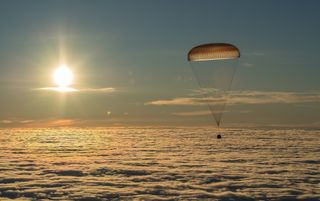
Three members of Expedition 53/54 safely returned to Earth on Feb. 27, 2018, after spending 168 days on the International Space Station. NASA astronauts Joe Acaba and Mark Vande Hei and Russian cosmonaut Alexander Misurkin touched down on the steppe of Kazakhstan at 9:31 p.m. EST (0231 GMT; 8:31 a.m. local time in Kazakhstan on Feb. 28) after a 3-hour trip in the Soyuz MS-06 spacecraft. [Full Story: Two Astronauts, Cosmonaut Land on Earth After 168 Days on Space Station]
Finding those "land legs"

Members of the search-and-rescue team helped the Soyuz MS-06 crewmembers out of their spacecraft following the landing. After spending 168 days in space, the crew had to get used to Earth's gravity again. Or, as NASA TV commentator Navias said during a live webcast of the landing, they had to get their "land legs" back.
To get the crew out of the Soyuz capsule, the search-and-rescue team lifted each crewmember out of the hatch on top of the spacecraft and sent them down a slide. Once they were on the ground, members of the search-and-rescue team carried the crewmembers to special reclining chairs, where they relaxed as they took in their first breaths of fresh air.
Soyuz in the sky
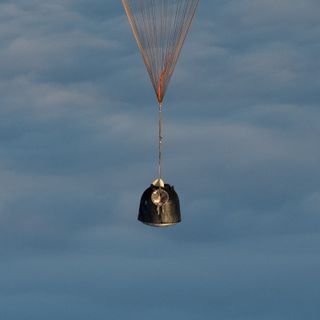
The Soyuz MS-06 descent module parachuted down to Earth with three Expedition 54 crewmembers on board. This cramped capsule is one of three modules that make up the Soyuz spacecraft. The other two parts — the orbital module and the propulsion module — are discarded in space and left to burn up in Earth's atmosphere. [Infographic: Russia's Manned Soyuz Space Capsule Explained]
Sun comes up, Soyuz comes down

The sun shined through the Soyuz MS-06 parachute as it rose over a blanket of clouds on the morning of the crew's landing. Winter weather and low clouds at the landing site made it difficult for cameras on the ground to see the capsule during the last few minutes of the crew's descent, but helicopter crews were able to capture photos from above the clouds.
The welcoming brigade
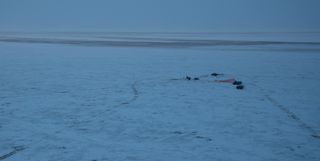
Search-and-rescue teams arrived at the landing site shortly after the Soyuz MS-06 spacecraft touched down in Kazakhstan. The spacecraft landed on a thick blanket of snow left behind by days of wintery weather conditions. While the weather forecast initially called for freezing rain on the day of the landing, there was no precipitation during their descent — only freezing-cold temperatures and overcast skies.
Soyuz comes in hot, lands in the cold
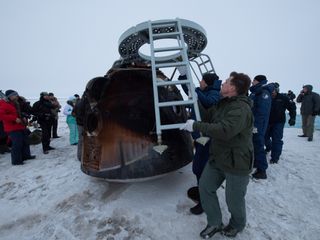
The charred Soyuz MS-06 spacecraft sat in several inches of snow as the search-and-rescue team prepared to help the Expedition 54 crew out of the spacecraft. As the Soyuz plummeted into Earth's atmosphere, the intense heat singed the outside of the capsule. A heat shield prevented the crew from roasting inside the spacecraft during the descent.
While Soyuz capsules often tip over during landings, this one landed upright, which helped to expedite the recovery process, NASA TV commentator Rob Navias said during a live webcast of the landing.
Landing preparations
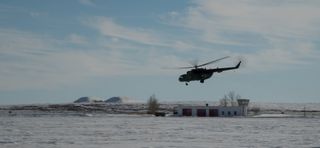
To prepare for the crew's return, Russian search-and-rescue teams boarded helicopters at the Karaganda airport in Kazakhstan on Feb. 26, one day before the landing, and flew to the small town of Zhezkazgan. The Soyuz spacecraft landed southeast of Zhezkazgan in a remote area on the steppe of Kazakhstan.
Mark Vande Hei
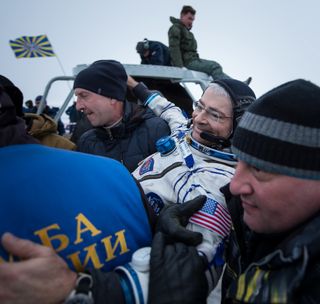
NASA astronaut and Expedition 54 flight engineer Mark Vande Hei smiled as he got a lift from the Soyuz capsule to his reclining chair. This expedition to the International Space Station was Vande Hei's first trip to space. During his 168-day mission, he conducted four spacewalks and spent a total of 20 hours and 45 minutes working outside the station. [Spacewalking Astronauts Breeze Through Robot 'Hand' Work on Space Station]
Alexander Misurkin
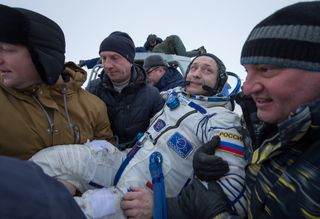
Russian cosmonaut Alexander Misurkin, commander of Expedition 54, appeared to be enjoying his first few minutes back on Earth as the search-and-recovery crew carried him from the Soyuz capsule to his reclining chair. During Expedition 54, Misurkin and his fellow cosmonaut Anton Shkaplerov broke the record for the longest Russian spacewalk when they spent 8 hours and 13 minutes working on a high-gain antenna. This was Misurkin's second trip to the International Space Station; his first was with Expedition 35/36, in 2013.
Joe Acaba

Covered in blankets and relaxing in a recliner, NASA astronaut and Expedition 54 flight engineer Joe Acaba was carried off to an inflatable medical tent, where flight surgeons conducted brief post-landing physical exams of the crew. Expedition 53/54 was Acaba's third mission to space following the space shuttle mission STS-119 in 2009 and Expedition 31/32 in 2012. He has now spent a total of 306 days in space and has competed three spacewalks with a cumulative spacewalking time of 19 hours and 46 minutes.
Chillin' together back on Earth
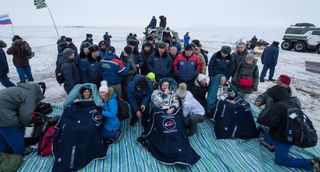
Surrounded by members of the search-and-rescue teams, NASA astronaut Joe Acaba (left), Russian cosmonaut Alexander Misurkin (center) and NASA astronaut Mark Vande Hei sat in reclining chairs outside the Soyuz MS-06 spacecraft. The crewmembers were covered in blankets provided by Roscosmos, Russia's space agency. Roscosmos also provides the Soyuz spacecraft and Sokol spacesuits used by all crewmembers who travel to the International Space Station.
Join our Space Forums to keep talking space on the latest missions, night sky and more! And if you have a news tip, correction or comment, let us know at: community@space.com.
Get the Space.com Newsletter
Breaking space news, the latest updates on rocket launches, skywatching events and more!

Hanneke Weitering is a multimedia journalist in the Pacific Northwest reporting on the future of aviation at FutureFlight.aero and Aviation International News and was previously the Editor for Spaceflight and Astronomy news here at Space.com. As an editor with over 10 years of experience in science journalism she has previously written for Scholastic Classroom Magazines, MedPage Today and The Joint Institute for Computational Sciences at Oak Ridge National Laboratory. After studying physics at the University of Tennessee in her hometown of Knoxville, she earned her graduate degree in Science, Health and Environmental Reporting (SHERP) from New York University. Hanneke joined the Space.com team in 2016 as a staff writer and producer, covering topics including spaceflight and astronomy. She currently lives in Seattle, home of the Space Needle, with her cat and two snakes. In her spare time, Hanneke enjoys exploring the Rocky Mountains, basking in nature and looking for dark skies to gaze at the cosmos.
